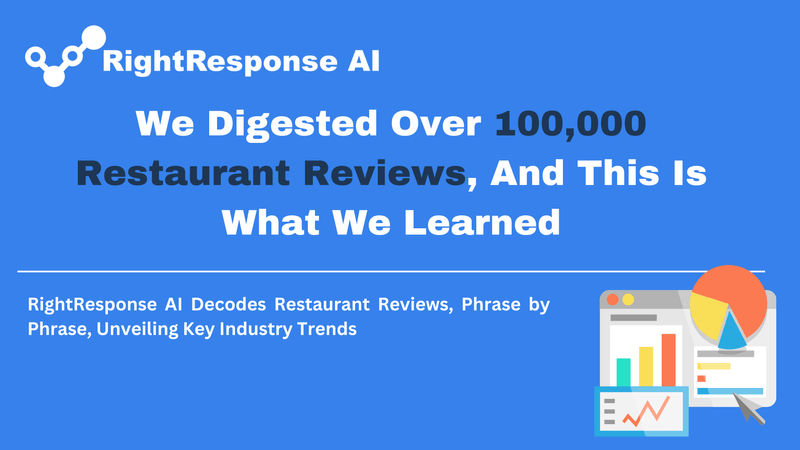
Highlights
- 64% of diners have a review cut-off of 3.5 (i.e., they won’t consider a restaurant if it has a review below 3.5), but only 2.7% of restaurants have average ratings below 3.5.
- Reviews are getting longer across all star ratings, rising on average from 30 words in early 2021 to roughly 45 words in early 2024. And 1 star reviews are about 4 times as long as 5 star reviews.
- While the review response rate at single location restaurants has remained steady near 15%, chain restaurant review response rates have grown from roughly 30% in early 2021 to nearly 60% today.
- Analysis has revealed a direct link between what we term “% positive mentions,” derived from a detailed sentiment analysis of individual phrases, and the overall average rating restaurants receive. In practical terms, this means that by examining % positive mentions, we gain the ability to delve deeper into specific topics of interest, gaining a clearer understanding of customer sentiment.
- For any given star rating, chain restaurants have a lower percentage of positive mentions compared to single location restaurants, posing a notable difference in customer satisfaction.
- Diners are least tolerant of bad service quality and most tolerant of negative perceptions of value.
- Negative mentions in reviews are linked to dramatic rating drops: there is a 61% chance of receiving a 1 or 2-star rating if there is a single negative mention of Service in a review, highlighting its pivotal role in customer satisfaction.
- Average ratings for the same set of restaurants stand higher on delivery platforms, at 4.5, compared to 4.1 on map-based platforms. Interestingly, when focusing solely on reviews that include text, a stark contrast emerges: text-based reviews on delivery platforms yield a significantly lower average rating of 2.7, as opposed to 3.9 for their map-based reviews.
About This Report
In the preparation of this report, our AI engine analyzed over 100,000 restaurant reviews. The key points of our methodology and findings are as follows:
- The analysis yielded over 270,000 sentence fragments subjected to in-depth evaluation.
- In our results, restaurants are characterized by:
- Price Group, indicated by $ signs ranging from $ to $$$$.
- Classification as either chain restaurants (between 10 and 30 locations) or single-location establishments.
- For certain establishments, a distinction between reviews for dine-in versus delivery services.
- For this report, we used 6 Categories: Food, Service, Atmosphere, Value, Location, and Health/Safety/Legal. The Categories encompass 29 Topics. For instance, the Service Category is further divided into the Topics of Staff, Efficiency, General Service, and Knowledge.
- Our Sentiment Analytics engine assigns each phrase to a Topic and Sentiment, which is then aggregated into a Category. For example, a statement like “I loved the tacos but hated the fries” results in both a positive and negative mention within the Category: Food and the Topic: Food Taste.
- We introduce a metric “% positive”, calculated as the ratio of positive Topic mentions to the total Topic mentions across all reviews for a restaurant. This metric, while less significant for an individual review, provides meaningful insight when considered in aggregate.
- Our ongoing analysis is presented here, with findings to date. We welcome further discussion, questions and feedback at analytics@rightresponseai.com.
- Additional insights were gained from our 2024 Restaurant Diner Survey Insights regarding diner perspectives on reviews and responses.
Part 1. Voices at the Table: Dissecting the Details in Diner Reviews
Navigating the Rating Landscape: How We Get There
Across the dataset, the average rating stands at 4.29. 66.5% of all reviews are 5 star, and each star level below that has a lower %, except for 1 star reviews, which exceed both 1 and 2 star reviews and have an extraordinary impact on average star rating calculations.

Clearing the Rating Bar: A Surmountable Hurdle
The cumulative distribution chart below of average restaurant ratings show an optimistic landscape: only 2.7% of restaurants score below a 3.0, and a slim 11% fall under a 3.5 threshold. Intriguingly, our diner survey highlighted that 64% consider 3.5 as their minimum acceptable rating for a dining option. The vast majority of restaurants comfortably meet or exceed this standard.

Chains vs. Singles: A Narrow Gap in Satisfaction
The comparison reveals minimal difference between Chain (4.26) and Single location restaurants (4.35). (Keep this in mind: we’ll revisit this when we look at “% positive mentions” metrics later in this report.)

The Vocal Minority: Text-rich Feedback in Low Ratings
There's a notable fluctuation in the percentage of reviews with text based on star ratings. While 63% of 3, 4, and 5-star reviews include text, this figure jumps to 87% for 1 and 2-star reviews. The 2 star reviews at high $ restaurants almost always include text. Customers are clearly more inclined to leave detailed feedback when expressing dissatisfaction, and more expensive restaurants also tend to have more reviews with text than lower price restaurants at most rating levels.

Expressive Dissatisfaction: More Words in Lower Ratings
Reviews tend to be longer when ratings are lower, indicating that dissatisfied customers are more verbose in their feedback.

The Growing Voice of the Customer: Reviews Get Lengthier Over Time
Additionally, there has been a steady increase in the length of reviews across all rating levels over time, suggesting a trend towards more comprehensive customer feedback. Further, low rating word count are multiples of high rating word counts.

Part 2. Engagement Evolution: Tracing the Trajectory of Review Responses
Rising to the Occasion: The Upward Curve of Response Rates
Over the period from early 2021 to late 2023, response rates to both positive and negative reviews have seen a significant increase, moving from just over 20% to approximately 50%. This uptick underscores a growing recognition of the importance of engaging with customer feedback over time.

Words That Matter: The Growing Length of Replies
Both review and response word counts have seen growth of roughly 50%.
.webp)
Balancing Act: Response Lengths Across the Dollar Spectrum
Across different price levels ($ to $$$$), the length of responses to reviews shows consistency, with $ and $$ establishments demonstrating slightly more variability. They tend to offer longer responses to lower ratings and shorter for higher ratings.

Chain Reaction: A Shift in Engagement Strategies
A pivotal shift occurred in early 2023, marking a clear differentiation in response patterns between chains and single location restaurants. While single locations maintained a response rate in the high teens, chains experienced a remarkable increase to nearly 60%, indicating a strategic emphasis on customer engagement.

Food for Thought: Navigating the Nuances of Engagement
- Diverging Paths of Engagement: In the quarter from November 2023 to January 2024, the disparity in response rates between chains and single location restaurants was pronounced; chains had an average response rate of 56%, whereas only 14% of single locations reached a response rate at or above 55%. This discrepancy underscores a critical juncture for single locations to reassess and enrich their engagement strategies.
- The Illusion of Engagement: While the observed increase in response rates, particularly among chains since early 2023, suggests a heightened level of engagement, a closer examination reveals a caveat. A significant portion of these responses were found to be generic, relying heavily on cut-and-paste or templated replies. This raises questions about the effectiveness of such engagement, as our survey of diners indicated that personalized interactions, those that genuinely address their feedback, tend to resonate more deeply with customers.
Part 3. Beyond the Stars: Navigating Nuances in Customer Feedback
The Sentiment Spectrum: Translating % Positive Mentions into Satisfaction Scores
Analysis, shown in the chart below, has revealed a direct link between what we term “% positive mentions,” derived from a detailed sentiment analysis of individual phrases, and the overall average rating restaurants receive. In practical terms, this means that by examining the % positive mentions, we gain the ability to delve deeper into specific topics of interest, gaining a clearer understanding of customer sentiment. This method offers a more comprehensive way to compare and contrast different aspects of customer feedback, enabling restaurants to benchmark their performance accurately and identify areas for improvement.

We can turn this data into a Table to convert % positive mentions into average ratings:

Star Ratings Unveiled: Seeing Beyond the Numbers
Here’s where it gets interesting! Diners don’t leave 4.2 ratings: choices are confined to whole numbers from 5 to 1. The chart below illustrates the "% positive" metric across star ratings for both chain and single location restaurants, revealing a clear pattern: at any given rating, patrons of chain restaurants report slightly lower satisfaction levels compared to those at independent venues.
Focusing on the 4-star evaluations, for example, the 74.5% positive feedback at single locations hints at an effective rating of 4.2/4.3, whereas the 65.1% for chains suggests a perception closer to 3.9/4.0.

This is an important point of understanding for restaurateurs and highlights the analytical advantage provided by RightResponse AI's approach to interpreting customer sentiments through % positive mentions.
The Tipping Point: Negative Sentiments and Their Impact on Ratings
In-depth analysis into Categories and Topics reveals significant insights into the impact of negative sentiments on review ratings.
The subsequent chart delineates the probability of reviews falling into specific star categories, conditioned on the presence of negative mentions across four defined Areas: Food, Service, Atmosphere, and Value. Negative mentions concerning Food carry a 52% probability of resulting in a 1 or 2-star review, juxtaposed with a sparse 10% probability for a 5-star review. Service receives heightened scrutiny, with negative feedback yielding a 61% chance of a 1 or 2-star review, and similarly, a 10% chance for a 5-star review.
Value perceived negatively incurs a more lenient response, exhibiting a 45% probability for 1 or 2-star review but a relatively higher 21% likelihood of receiving a 5-star review. This data highlights the differential impact of negative sentiments across Categories on the rating spectrum.

Part 4. Delving into Delivery: A Different Dimension of Reviews
Silent Majority: The Text-Filled Divide Between Delivery and Map-Based Reviews
When comparing customer feedback across platforms, we discover that the landscape of reviews on delivery services diverges significantly from those found on traditional map-based directories. All the results below compare delivery ratings and map ratings for the same set of restaurants.
To begin, the fraction of reviews containing text on delivery platforms is notably distinct, standing at 2%, compared to 66% for map-based reviews. This suggests a difference in engagement or the propensity to leave detailed feedback based on the review platform.

Scores of Surprise: Delivery Platforms Edge Ahead in Overall Ratings
Contrary to initial expectations, overall ratings on delivery platforms outshine those on maps. On the left, you can see the average delivery rating of 4.5 against the map average of 4.1, and on the right, you can see the star rating breakdown.

.webp)
The Detailed Dissent: Text Reveals Harsher Reality on Delivery Platforms
However, the narrative shifts when narrowing the focus to reviews accompanied by text. Here, the plot thickens: text-based reviews on delivery platforms plunge to an average rating of 2.7, a stark contrast to the 3.9 average observed in map-based reviews with text, and you can see the detail on the right.


Overall Conclusion
By leveraging advanced AI for sentiment analysis, we offer insights into the subtleties of diner feedback. Our study casts light on the benefits of AI-enabled sentiment analysis for the restaurant industry, bringing into focus the overarching trends transcending individual ratings.
About RightResponse AI
RightResponse AI is a comprehensive reputation and review management platform built from the ground up with advanced AI. This includes the automation and personalization of review responses, in-depth sentiment analysis for companies and their competitors, more efficient review request processes and comprehensive dashboards. Deployment of RightResponse AI's Sentiment Analytics engine also allows companies to engage in sophisticated competitive benchmarking, enhancing performance and customer satisfaction. Capabilities include:
- Generative AI for Customer Review Responses: Automates and tailors responses to customer reviews for timely, informative engagement.
- Advanced Sentiment Analysis: Utilizes AI for Aspect-Based Sentiment Analysis (ABSA) to analyze feedback for both customers and competitors, offering actionable insights and identifying improvement areas.
- Generative AI for Review Requests: Personalize each review request with generative AI, boosting the chances of receiving customer feedback.
For companies looking for a one-stop best-of-breed local SEO solution, RightResponse AI’s suite of services also includes two additional modules:
- Google Map Rankings and SEO Data Integration: Enhances local SEO strategies by tracking Google Maps rankings for both the business and its competitors. Integrates local SEO data (powered by Ahrefs) into dashboards, aiding in determining organic strategies.
- Listings Management: Simplifies the management of business listings across publishers, ensuring data accuracy and aiding in local SEO optimization (powered by Uberall).
RightResponse AI provides this unified platform for location-based businesses with the express purpose of climbing the Google Map rankings in each of their locations.
Try RightResponse AI free for 14 days
Get on top of your customer reviews to get the critical insightsyou need to improve customer acquisition and retention.
No obligation. No credit card required.
Try it free for 14 days
Read More from Our Blog

The Critical Role of AI in Restaurant Reputation Management

Our Analysis of Over 100,000 Restaurant Reviews

.svg)